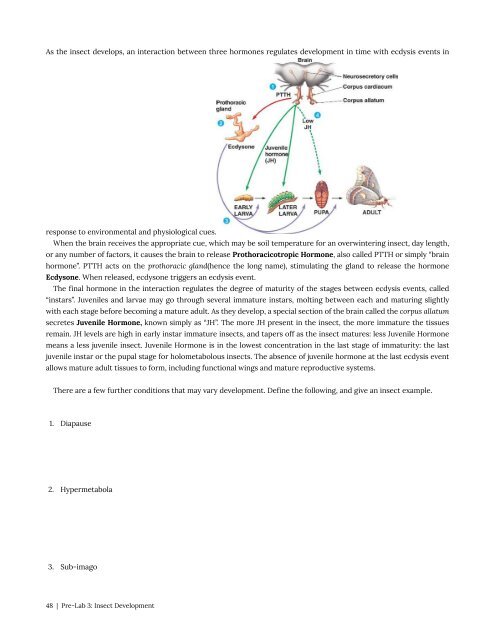Entomology 311 Lab Manual - 1st Edition, 2019
Entomology 311 Lab Manual - 1st Edition, 2019
Entomology 311 Lab Manual - 1st Edition, 2019
Create successful ePaper yourself
Turn your PDF publications into a flip-book with our unique Google optimized e-Paper software.
As the insect develops, an interaction between three hormones regulates development in time with ecdysis events in<br />
response to environmental and physiological cues.<br />
When the brain receives the appropriate cue, which may be soil temperature for an overwintering insect, day length,<br />
or any number of factors, it causes the brain to release Prothoracicotropic Hormone, also called PTTH or simply “brain<br />
hormone”. PTTH acts on the prothoracic gland(hence the long name), stimulating the gland to release the hormone<br />
Ecdysone. When released, ecdysone triggers an ecdysis event.<br />
The final hormone in the interaction regulates the degree of maturity of the stages between ecdysis events, called<br />
“instars”. Juveniles and larvae may go through several immature instars, molting between each and maturing slightly<br />
with each stage before becoming a mature adult. As they develop, a special section of the brain called the corpus allatum<br />
secretes Juvenile Hormone, known simply as “JH”. The more JH present in the insect, the more immature the tissues<br />
remain. JH levels are high in early instar immature insects, and tapers off as the insect matures: less Juvenile Hormone<br />
means a less juvenile insect. Juvenile Hormone is in the lowest concentration in the last stage of immaturity: the last<br />
juvenile instar or the pupal stage for holometabolous insects. The absence of juvenile hormone at the last ecdysis event<br />
allows mature adult tissues to form, including functional wings and mature reproductive systems.<br />
There are a few further conditions that may vary development. Define the following, and give an insect example.<br />
1. Diapause<br />
2. Hypermetabola<br />
3. Sub-imago<br />
48 | Pre-<strong>Lab</strong> 3: Insect Development


















